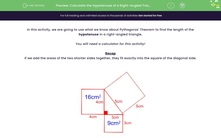In this activity, we are going to use what we know about Pythagoras' Theorem to find the length of the hypotenuse in a right-angled triangle.
You will need a calculator for this activity!
Recap
If we add the areas of the two shorter sides together, they fit exactly into the square of the diagonal side.
The area of that square is 5 x 5 = 25 cm2
16 cm2 + 9 cm2 = 25 cm2
We call the diagonal side, opposite the right angle the hypotenuse.
If we know the two shorter sides we can work out the area on the hypotenuse!
If we square root this, we get the length of the hypotenuse!
Let's try a question without drawing the squares!
Example
Calculate the length of the missing side (hypotenuse, H) below.
Answer
Remember the missing hypotenuse can be found because:
The shorter sides squared and added together = hypotenuse squared
In short:
62 + 82 = H2
36 + 64 = H2
100 = H2
H = the square root of 100
H = 10
This is the button on the calculator which works out the square root for you.
Let's try some more like this!








